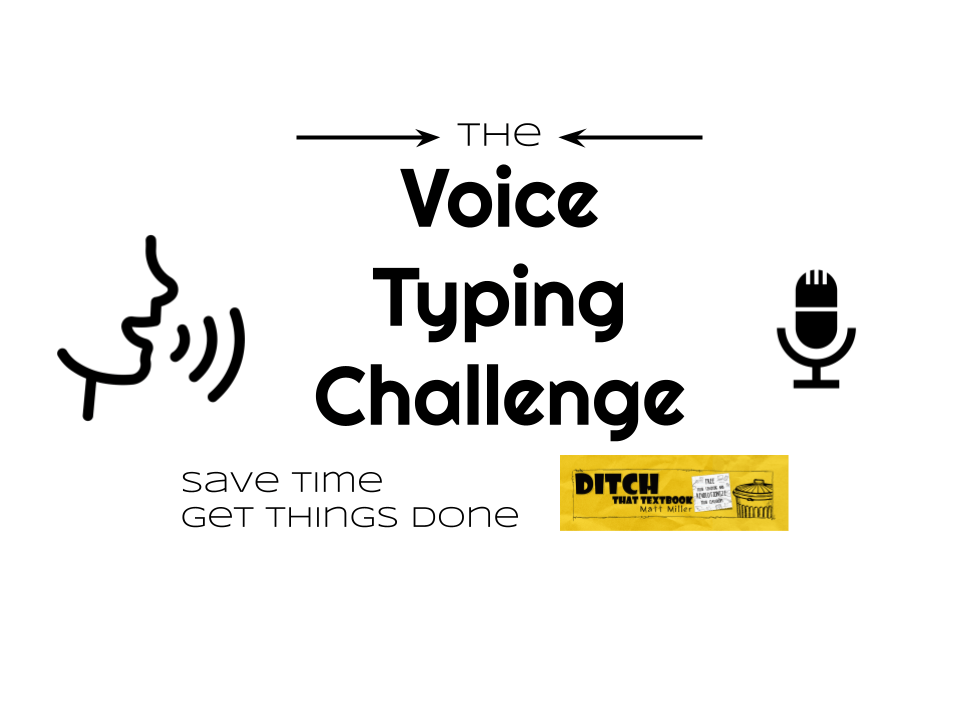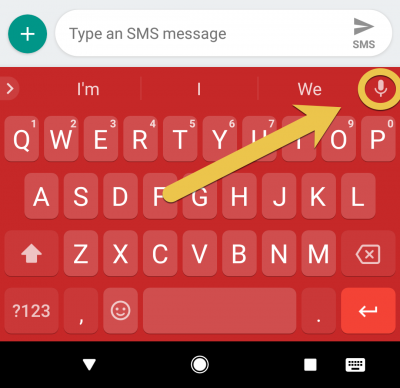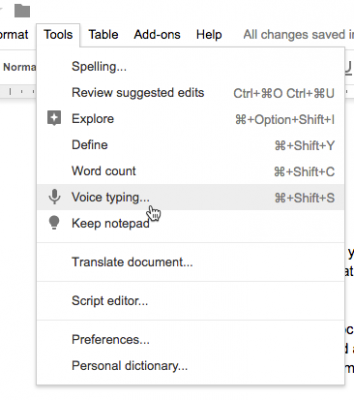
We talk faster than we type. Using voice typing (dictation) can save us tons of time in the classroom. Learn how and take the challenge!
I had a project recently that was going to require a lot of sitting and typing. But I was stuck in the car and couldn't get started on it.
I knew that I needed to get to work on it, so what could I do?
Voice typing.
I knew there were several apps and tools that let you type with your voice, but I had never taken the plunge and really given them a shot.
So, with several hours of driving ahead of me, I fired up a new Google Doc on my phone and started talking to it.
After some starting and stopping, I finished that trip with almost 4,000 words written … all the while keeping my eyes on the road.
It wasn't perfect, and I still needed to get back in and edit it, but I started to see the potential in typing with my voice.
The act of voice typing (or dictation, or speech-to-text, as it's also called) makes some of us uncomfortable. It doesn't seem natural.
But it can help us get things done very quickly.
In this post, we'll look at:
- why we should use voice typing
- why we're so squeamish about it
- how to use voice typing on a variety of devices
- tips for succeeding with voice typing
Every teacher I've met talks about a lack of time as their greatest barrier to doing the things they want to do.
When it comes to writing emails, creating learning materials for students, and writing pretty much anything, voice typing can speed you up and help you buy back some of that much-needed time.
In fact, I'm taking the plunge and I'm voice typing this entire blog post. (And so far, I'm flying through it!)
Why use voice typing
Simply put, you can talk a lot faster than you can type.
Most people can type 38 to 40 words per minute. However, when you speak, that speed surges to 150 words per minute.
The speed and efficiency is enough reason to give it a shot in the first place.
Most anyone that struggles with typing -- including students with special needs -- can benefit from voice typing. If the keyboard is a barrier to expressing one's ideas, voice typing essentially removes that barrier.
If you're like me, the convincing isn't in the statistics of speed of use.
It's in getting over yourself and trying it.
I think there's a reason for that.
Why we're so uneasy about voice typing
There have been plenty of times when I've been on the go and could see the benefits of using speech to text.
I could respond to texts. I could send tweets. I could write emails.
Essentially, I could get work done without needing to sit in front of the keyboard.
I saw two factors holding me back: how awkward the whole thing feels and my self-consciousness.
Part of the reason it's so hard to start, I believe, is that we're forcing ourselves to do the same work with different parts of our brain than we're used to.
According to this article from the Public Library of Science, typing with your fingers activates three parts of your brain:
- the left superior parietal lobule, which processes sensations from the hand,
- the left supramarginal gyrus, which is believed to process language, and
- the left premotor cortex (near Exner’s area), which is believed to deal with writing and reading.
Voice typing, however, would seem to rely totally on speech, which is handled by Broca's area in the brain.
When you try voice typing, if it feels as hard as learning to ride a bike. There's a reason for that. Your brain is learning a skill that's almost brand new.
Some practice will solve all of that.
However, practice does not help us feel less self-conscious about it all.
Here's how I battled the self-consciousness part of voice typing: I eliminated risks that I was worried about.
Yep, That means I started trying voice typing when I was all alone. No one to hear me. No one to judge me.
It was awkward for a while. However, I reminded myself that the potential benefits were huge if I could just get the hang of it. And who did I have to be embarrassed in front of? Just myself.
My next big leap was to try voice typing in public. (Somehow, it felt less daunting to do this around total strangers than it did around people that I knew.)
To do this, I held my phone close to my face and mumbled quietly so no one could hear me.
In a busy department store, grocery store, or other public area, nobody is really paying attention to you anyway. I've seen tons of people talking to their phones without having them held up to their ear. I just became like one of them to everybody else.
It worked. I didn't even have to speak at a normal volume for my phone to pick up what I was saying.
Getting over your inhibitions is the first part. Now, let's dig into the nuts and bolts of speech to text.
How to start using voice typing
There are plenty of options out there for speech to text, ranging from expensive software to free tools you have access to right now.
Of the ones I have tried, I have two favorites:
1. The microphone icon on the keyboard of my Android phone
2. Google Docs voice typing (Google support article on voice typing)
I have tried a couple Chrome extensions and a Gmail add on, but none of them seems to have the accuracy and reliability of my phone and Google Docs.
Plus, I figure no matter what I have to do, I will either have access to my phone or Google Docs on a computer or Chromebook.
Here's the beauty of using Google docs for voice typing: no matter what you're doing on your computer, you can type with your voice in Google Docs and copy and paste it over to practically any program or website.
(Can I just stop and say that I'm amazed at how fast I'm writing this blog post with my voice? I even feel like I'm getting better at it just in this sitting.)

Here's what the button looks like on my Android phone. Here's an article explaining how to activate voice typing (voice input) on Android phones.

Here's what the voice typing (dictation) button looks like on an iPhone or iPad. Here's an article explaining how to activate voice typing (dictation) on iOS devices.

Here's how to find voice typing in Google Docs. Choose it and click the microphone button that appears to start voice typing.
Tips you need to know
If you're going to try voice typing, you will realize quickly that there are certain things that you can do with a keyboard that you might not know how to do with your voice intuitively.
For example: punctuation. There are no punctuation keys in your voice. So how do you do it?
Google Docs voice typing, as well as the speech to text on my phone, support the following punctuation and commands. They seem to be fairly standard commands, so I would imagine most voice typing options use them as well.
- Period
- Comma
- Exclamation point
- Question mark
- New line
- New paragraph
At first, saying the word “period” at the end of your sentences seems really strange. But once you get the hang of it, you start to add punctuation to your voice-typed sentences as seamlessly as you did typing with your fingers.
In Google Docs, you can even format your document and navigate around the page with your voice. (Click here and scroll to Step 3: Voice commands.)
This isn't something that I've really used at all yet. However, if you found a couple of commands that you really liked, I could see it making voice typing even more handy.



So fun.